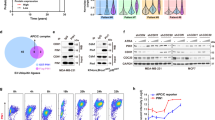Abstract
The helix–loop–helix protein Id-1 has been suggested to play a positive role in cell proliferation and tumorigenesis of many types of human cancers. However, little is known about the molecular mechanism involved in the function of Id-1. In this study, using four stable Id-1 transfectant clones, we investigated the involvement of MAPK signaling pathway in the Id-1 induced serum independent prostate cancer cell growth. Our results demonstrated that both transient and stable ectopic Id-1 expression in prostate cancer LNCaP cells led to activation of the Raf/MEK1/2 signaling pathway. In addition, inhibition of MEK1/2 phosphorylation by one of its inhibitors, PD098059, resulted in the decreased cell cycle S phase fraction and cell growth rate, suggesting that activation of MAPK signaling pathway is essential for Id-1 induced prostate cancer cell proliferation. Furthermore, treatment with antisense oligonucleotide complementary to Id-1 mRNA in PC-3 and DU145 cells resulted in a decreased Id-1 expression which was accompanied by decreased Egr-1 protein. Our results suggest for the first time that the function of Id-1 is associated with MAPK signaling pathway activation and indicate a possible novel mechanism in which Id-1 regulates prostate cancer cell growth and tumorigenesis.
This is a preview of subscription content, access via your institution
Access options
Subscribe to this journal
Receive 50 print issues and online access
$259.00 per year
only $5.18 per issue
Buy this article
- Purchase on Springer Link
- Instant access to full article PDF
Prices may be subject to local taxes which are calculated during checkout





Similar content being viewed by others
References
Alani RM, Hasskarl J, Grace M, Hernandez MC, Israel MA, Munger K . 1999 Proc. Natl. Acad. Sci. USA 96: 9637–9641
Alani RM, Young AZ, Shifflett CB . 2001 Proc. Natl. Acad. Sci. USA 98: 7812–7816
Bain G, Cravatt CB, Loomans C, Alberola-Ila J, Hedrick SM, Murre C . 2001 Nature Immunol. 2: 165–171
Benezra R, Rafii S, Lyden D . 2001 Oncogene 20: 8334–8341
Dudley DT, Pang L, Decker SJ, Bridges AJ, Saltiel AR . 1995 Proc. Natl. Acad. Sci. USA 92: 7686–7689
Eid MA, Kumar MV, Iczkowski KA, Bostwick DG, Tindall DJ . 1998 Cancer Res. 58: 2461–2468
Fan M, Du L, Stone AA, Gilbert KM, Chambers TC . 2000 Cancer Res. 60: 6403–6407
Gioeli D, Mandell JW, Petroni GR, Frierson Jr HF, Weber MJ . 1999 Cancer Res. 59: 279–284
Hara E, Yamaguchi T, Nojima H, Ide T, Campisi J, Okayama H, Oda K . 1994 J. Biol. Chem. 269: 2139–2145
Benezra R, Davis RL, Lockshon D, Turner DL, Weintraub H . 1990 Cell 61: 49–59
Kawashita Y, Ohtsuru A, Kaneda Y, Nagayama Y, Kawazoe Y, Eguchi S, Kuroda H, Fujioka H, Ito M, Kanematsu T, Yamashita S . 1999 Hum. Gene Ther. 10: 1509–1519
Kleeff J, Ishiwata T, Friess H, Buchler MW, Israel MA, Korc M . 1998 Cancer Res. 58: 3769–3772
Langlands K, Down GA, Kealey T . 2000 Cancer Res. 60: 5929–5933
Lin CQ, Singh J, Murata K, Itahana Y, Parrinello S, Liang SH, Gillett CE, Campisi J, Desprez PY . 2000 Cancer Res. 60: 1332–1340
Ling MT, Chan KW, Choo CK . 2001 J. Endocrinol. 170: 287–296
Maruyama H, Kleeff J, Wildi S, Friess H, Buchler MW, Israel MA, Korc M . 1999 Am. J. Pathol. 155: 815–822
Nickoloff BJ, Chaturvedi V, Bacon P, Qin JZ, Denning MF, Diaz MO . 2000 J. Biol. Chem. 275: 27501–27504
Ohtani N, Zebedee Z, Huot TJ, Stinson JA, Sugimoto M, Ohashi Y, Sharrocks AD, Peters G, Hara E . 2001 Nature 409: 1067–1070
Olson EN, Klein WH . 1994 Genes Dev. 8: 1–8
Ouyang XS, Wang X, Lee DT, Tsao SW, Wong YC . 2001 Carcinogenesis 22: 965–973
Ouyang XS, Wang X, Lee DT, Tsao SW, Wong YC . 2002a J. Urol. 167: 2598–2602
Ouyang XS, Wang X, Ling MT, Wong HL, Tsao SW, Wong YC . 2002b Carcinogenesis 23: 721–725
Peverali FA, Ramqvist T, Saffrich R, Pepperkok R, Barone MV, Philipson L . 1994 EMBO J. 13: 4291–4301
Polsky D, Young AZ, Busam KJ, Alani RM . 2001 Cancer Res. 61: 6008–6011
Ristow HJ . 1996 Growth Regul. 6: 96–109
Sakurai D, Yamaguchi A, Tsuchiya N, Yamamoto K, Tokunaga K . 2001 Biochem. Biophys. Res. Commun. 284: 436–442
Schindl M, Oberhuber G, Obermair A, Schoppmann SF, Karner B, Birner P . 2001 Cancer Res. 61: 5703–5706
Tournay O, Benezra R . 1996 Mol. Cell. Biol. 16: 2418–2430
Zebedee Z, Hara E . 2001 Oncogene 20: 8317–8325
Acknowledgements
This work was supported by RGC grants to YC Wong (HKU 7186/99M and HKU 7314/01M) and Area of Excellence Scheme (Project No. AoE/P-10/01).
Author information
Authors and Affiliations
Corresponding author
Rights and permissions
About this article
Cite this article
Ling, MT., Wang, X., Ouyang, XS. et al. Activation of MAPK signaling pathway is essential for Id-1 induced serum independent prostate cancer cell growth. Oncogene 21, 8498–8505 (2002). https://doi.org/10.1038/sj.onc.1206007
Received:
Revised:
Accepted:
Published:
Issue Date:
DOI: https://doi.org/10.1038/sj.onc.1206007
Keywords
This article is cited by
-
The Id-protein family in developmental and cancer-associated pathways
Cell Communication and Signaling (2017)
-
Epigenetic regulation of transcription factor promoter regions by low-dose genistein through mitogen-activated protein kinase and mitogen-and-stress activated kinase 1 nongenomic signaling
Cell Communication and Signaling (2016)
-
A potential therapeutic strategy for inhibition of ocular neovascularization with a new endogenous protein: rhEDI-8t
Graefe's Archive for Clinical and Experimental Ophthalmology (2012)
-
Prostate cancer cells modulate osteoblast mineralisation and osteoclast differentiation through Id-1
British Journal of Cancer (2010)
-
Inhibitor of DNA Binding-1 Overexpression in Prostate Cancer: Relevance to Tumor Differentiation
Pathology & Oncology Research (2009)



